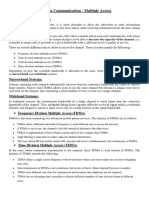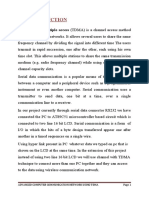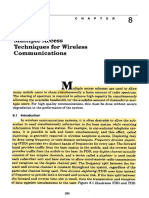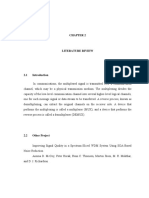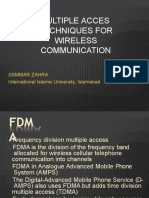Professional Documents
Culture Documents
An Efficient Strategy For Multiuser Detection in Cdma
An Efficient Strategy For Multiuser Detection in Cdma
Uploaded by
Niveli Naivi0 ratings0% found this document useful (0 votes)
27 views40 pagesThis document provides an overview of efficient multi-user detection strategies in Code Division Multiple Access (CDMA) wireless communication systems. It discusses the optimal detection problem in CDMA and presents several suboptimal approaches. The objective is to investigate a new sparse CDMA paradigm using belief propagation for near-optimal multi-user detection with low complexity. An efficient algorithm is proposed based on modified belief propagation with heuristic Gaussian approximations.
Original Description:
Original Title
p1
Copyright
© Attribution Non-Commercial (BY-NC)
Available Formats
PPT, PDF, TXT or read online from Scribd
Share this document
Did you find this document useful?
Is this content inappropriate?
Report this DocumentThis document provides an overview of efficient multi-user detection strategies in Code Division Multiple Access (CDMA) wireless communication systems. It discusses the optimal detection problem in CDMA and presents several suboptimal approaches. The objective is to investigate a new sparse CDMA paradigm using belief propagation for near-optimal multi-user detection with low complexity. An efficient algorithm is proposed based on modified belief propagation with heuristic Gaussian approximations.
Copyright:
Attribution Non-Commercial (BY-NC)
Available Formats
Download as PPT, PDF, TXT or read online from Scribd
Download as ppt, pdf, or txt
0 ratings0% found this document useful (0 votes)
27 views40 pagesAn Efficient Strategy For Multiuser Detection in Cdma
An Efficient Strategy For Multiuser Detection in Cdma
Uploaded by
Niveli NaiviThis document provides an overview of efficient multi-user detection strategies in Code Division Multiple Access (CDMA) wireless communication systems. It discusses the optimal detection problem in CDMA and presents several suboptimal approaches. The objective is to investigate a new sparse CDMA paradigm using belief propagation for near-optimal multi-user detection with low complexity. An efficient algorithm is proposed based on modified belief propagation with heuristic Gaussian approximations.
Copyright:
Attribution Non-Commercial (BY-NC)
Available Formats
Download as PPT, PDF, TXT or read online from Scribd
Download as ppt, pdf, or txt
You are on page 1of 40
AN EFFICIENT STRATEGY FOR
MULTIUSER DETECTION IN CDMA
Contents
problem
Overview
Objective
Approaches
Algorithms
Flow chart
Results
conclusions
Future work
Problem Outline
In a Code-Division multiple access (CDMA) system,
a number of users communicate with a base station
simultaneously over the same frequency band.
Optimal detection in such systems is equivalent to a test of
an exponential number of hypotheses about the data
symbols of all users, which is NP-complete and hence
prohibitively complex for all but systems with very
few users. Numerous suboptimal multiuser detectors are
decorilating detector, the linear minimum mean-square
error (MMSE) detector, and the successive cancellers .
Overview
People always wanted to communicate and their demands grew
with the possibilities offered by technology. Now days,
modern technology enables mobile communications in many
situations. An important component in mobile communications
is non-cellular wireless communication system for short
distances. Wireless communication systems can be roughly
divided into two categories: cellular and non-cellular systems.
In cellular systems the area to be covered is divided into
number of cells. Non-cellular systems form another category of
wireless communication systems for which no infrastructure is
required.
Objective
Code-division multiple access (CDMA) is the basis of a family of advanced air
interfaces in current and future generation network., which enables near-optimal
multiuser detection using belief propagation (BP) with low-complexity.
The scheme is in part inspired by capacity-approaching low-density parity-check
(LDPC) codes and the success of iterative decoding techniques.
Thedegradation factor, known as the multiuser efficiency, can be determined
from a fixed-point equation. The results in this work apply to a broad class of
sparse, semi-regular CDMA systems with arbitrary input and power distribution.
,
degradation factor, known as the
DESIGN METHODOLOGY
This work investigates a new paradigm of CDMA,
called sparsely spread CDMA or simply sparse CDMA,
which recently emerged in the literature
Multi user detection based on modified BP with heuristic
Gaussian approximation was originally proposed for the
usual dense CDMA
More recently studied sparse CDMA of the regular LDPC
code type using the replica method and verified
their findings numerically.
MULTI ACESS COMMUNICATION
The term Multiple access refers in satellite communications.
Multiple Access method is a definition of how radio spectrum is
divided in to channels and how channels are allocated to many users of
the system
Access technologies are classified as two types---1) Narrowband,
2) Wideband
In a narrowband Multiple access system, the available radio spectrum
is divided into a large number of narrowband channels.
FDMA,TDMA, are come under narrowband systems. In Narrowband
FDMA, a user is assigned a particular channel, which is not shared by
other users in vicinity. Narrowband TDMA, on the other hand, allows
users to share the same radio channel but allocates a unique time slot to
each user
WIDEBAND SYSTEMS
In wideband systems, the transmission bandwidth of a single channel is much larger than
the coherence bandwidth of the channel. Code division Multiple access technique comes
under wideband systems .In Wideband Multiple access systems a large number of
transmitters are allowed to transmit on the same channel. TDMA allocates time slots to
the many transmitters on the same channel and allows only one transmitter to access the
channel at any instant of time, where as spread spectrum CDMA allows all of the
transmitters to access the channel at the same time
Types of multiple access techniques
FREQUENCY DIVISION MULTIPLE ACCESS:
In FDMA, the available radio spectrum is divided into channels of fixed
bandwidth, which are then assigned to different users. FDMA is the basis
for first generation (analog) communication systems. With FDMA only one
subscriber is assigned a channel at a time FDMA is characterized by
continuous access to satellite in a given frequency band.
Frequency division multiple access
Time division multiple access
TIME DIVISION MULTIPLE ACCESS :
In TDMA, time is divided into intervals of regular length and then each
interval is subdivided into slots. Each user is assigned a slot number
and can transmit over the entire bandwidth during its slot with in each
interval. Second Generation systems use TDMA as the Multiple
access technique
Time Division Multiple Access
Code division multiple access
Code division multiple access system:
In a code-division Multiple-access (CDMA) communication system, a
communication channel with a given bandwidth is accessed by all the
users simultaneously. The different mobile users are distinguished at
the base station receiver by the unique spreading code .
The frequency of this carrier is the same for all users. At the receiver
separation is possible because each user spreads the spreading codes.
This technique is used for channels, which suffer frequency selective
fading or interference
Each code must be easily distinguishable from a replica of itself shifted
in time.
Each code must be easily distinguishable regardless of other codes
used on the network.
CDMA is the most suitable Multiple access transmission technology for
Mobile Communications and all the 3rd Generation. Mobile
Communication Standards suggest CDMA for the Air-Interface. The main
reason for the success of this technology is the huge increase in capacity
and coverage covered by CDMA systems when compared to other analog
FDMA,TDMA.This is the reason why one refers to Spread Spectrum
Multiple Access.
Code Division Multiple Access
CDMA CAPACITY
Resistant to narrow band interference
Resistant to multi path fading
No hard limit on number of users (soft capacity)
As number of users on a frequency increase the interference level increases
and BER increases for all users
Signal propagation characteristics
The In general, a signal transmitting in a channel experiences two types of
fading: (1) Large-scale fading; and (2) Small-scale fading.
The mechanisms behind these two fading types are diverse, but can
generally be attributed to reflection, diffraction and scattering .These three
propagation mechanisms are illustrated in figure .Other transmission
impairments in the wireless channel include free space loss, thermal noise
and atmospheric absorption.
of.
REFLECTION :
Reflection occurs when a propagating electromagnetic wave encounters a
surface that is large relative to the wavelength of the propagating wave [1].
This reflected wave as illustrated in figure may interfere constructively or
destructively at the receiver due to the change in phase shift after reflection.
Sources for reflections include the surface of the earth, buildings and walls.
DIFFRACTION
Figure that diffraction can occur at the edge of an impenetrable body or at
a surface with sharp irregularities that is large compared to the wavelength
of the radio wave. The secondary waves resulting from such edges or
surfaces are partially reflected and retransmitted with a bend of waves
around the obstacle. This allows the signal to be transmitted even when
there is no LOS path between the transmitter and the receiver.
DIFFRACTION OF A WAVE:
SCATTERING
Scattering occurs when the radio path between the transmitter and receiver
consists of large amount of objects with dimensions that are small
compared to the wavelength of the signal. Figure shows that the scattered
waves can be produced by rough surfaces or by other irregularities in the
channel such as foliage and traffic signs.
Scattering of waves
LARGE-SCALE FADING
Large-scale fading is primarily attributed to path loss when the
received signal strength decays over relatively large distances (several
hundreds or thousands of meters) between the transmitter and the
receiver.. It is otherwise known as slow fading or shadowing.
SMALL-SCALE FADING
Small-scale fading as shown in figure manifests itself as rapid
fluctuations in the voltage envelope of the received signal over a short
period of time or travel distance (a few wavelengths). It is caused by
the interference between two or more versions of the transmitted signal
arriving at the receiver with a spread of different times. These time-
shifted signals are called multipath signals, which can be represented
as taps in an impulse-response model of a channel.
Spreading Techniques in
CDMA
SPREAD SPECTRUM
Spread-spectrum radio communications, long a favorite technology, of
the military because it resists jamming and is hard for an enemy to
intercept
spread-spectrum signals, which are distributed over a range of
frequencies and then collected onto their original frequency at the
receiver
Requirements
A system is defined to be a spread spectrum system if it fulfills the
following requirements:
The signal occupies a bandwidth much in excess of the minimum
bandwidth necessary to send the information.
Spreading is accomplished by means of a spreading signal, often
called a code signal, which is independent of the data .
many benefits of spread spectrum: Interference rejection, signal
hiding, frequency band sharing (code-division Multiplexing), anti-jam
Properties.
Concept of Spread Spectrum
THE CONCEPT OF SPREAD SPECTRUM
SYSTEM
The capacity of any communications channel is defined by CE
Shannons channel capacity formula
2
log 1
S
C Bw
N
(
= +
(
Equation gives the relationship between the theoretical ability of a
channel and a given bandwidth of a channel. Channel capacity is
increased by increasing the channel bandwidth, the transmitted power,
or a combination of both.
CDMA systems can be engineered to operate at much lower SNRs to
achieve good performance.
1.44log 1
e
C S
Bw N
(
= +
(
1.44
C N
Bw
S
~
1.44
C N
Bw
S
~
1.44
C N
Bw
S
~
SPREADING SEQUENCES
As the spreading sequence generation is the first step in understanding
CDMA mobile communications, some well-known code generators are
PN Sequences
Maximal Length Sequences
Gold Codes
Kasami Sequences
Orthogonal Codes
Walsh Codes
Orthogonal Gold Codes
Multi-rate Orthogonal Gold Codes
Orthogonality Preservation between Multi-Rate Orthogonal Codes
TECHNIQUES USED FOR SPREAD SPECTRUM
Spread spectrum systems have been classified by their architecture and modulation concepts. They
are
1. Direct sequence (pseudo-noise).
2. Frequency hopping.
3. Time hopping.
4. Chirp.
5. Hybrid methods.
Direct Sequence Spread Spectrum (DSSS) where a carrier is modulated by a digital code in which the
code bit rate is much larger than the information signal bit rate. These systems are also called
pseudonoise (PN) systems.
Frequency Hopping Spread Spectrum (FHSS) where the carrier frequency is shifted in discrete
increments in a pattern generated by a code sequence.
.
ADVANTAGES OF SPREAD SPECTRUM
Improved interference rejection
Low-density power spectra for signal hiding
High-resolution ranging
Secure communications
Antijam capability
Graceful degradation of performance as the number
of simultaneous users of an RF channel increases
Lower cost of implementation
Readily available IC components
System Architechture
code 1
User 1
code 2
User 2 code 2 user 2
code N
User N
Spreading
Spreading
Spreading
RF Channel
+
Estimator
(MAP/BP)
Decision
For the implementation of Communication system a CDMA based
Spread spectrum communication architecture is developed
The receiver is designed as a rake receiver.
Rake receivers are used in CDMA systems for two reasons, the 1st
reason is inter-symbol interference cancellation and the second reason
is to utilize the multi-path diversity .
The idea of a Rake receiver is to identify a number of different multi-
path components both in time and phase, thus utilizing the created
multi-path diversity.
For the implementatio .
MAP ALGORITHM
The MAP decoding also known as BCJR algorithm The MAP
algorithm is computationally complex and sensitive to SNR
mismatch
The MAP decoding algorithm is a recursive technique that computes
the Log-Likelihood Ratio
In this algorithm we are taken one reference error, we are estimating
another error.
If estimated error is > ref error it must be ref error or else
If estimated error is < ref error it must be estimated error
If degree is increasing the total system is complicated. so the
algorithm takes more time,
In b.p it is rectified.
.
BP ALGORITHM FOR MULTI
USER DETECTION
BP is an efficient iterative message-passing algorithm for computing the marginal
posterior distributions. Each node in the factor graph sends messages to its
neighbors during each iteration and after several iterations, inference can be
made based on the messages exchanged in the final round.
Consider the CDMA system. Let the realization of S and the amplitudes A be
denoted by s and a respectively.
In each iteration of BP, messages are first sent from symbol nodes to chip nodes;
each chip node then computes messages to send back to the symbol nodes based
on the previously received messages. These chip-to-symbol messages will then be
used to generate the new symbol-to-chip messages in the next iteration .the
shorthand represent the message from the symbol node k to chip node l. and
represent the message in the reverse direction at the t-iteration.
The iterative BP algorithm for computing the a posteriori distribution
of all symbols.
RESULT OBSERVATION
For the Evaluation of the proposed sparse code allocation and fixed
code allocation in CDMA system, Matlab modeling is developed and
evaluated with varying SNR, offered load and channel fading factor
for Sparse code allocation BER is falling compared to fixed code
allocation. As the load increases the system performance is
decreasing.
Fig Overall system BER vs.SNR for
Low load,Low SNR,Low fading
0 2 4 6 8 10 12 14
10
-0.9
10
-0.8
10
-0.7
10
-0.6
10
-0.5
10
-0.4
10
-0.3
SNR (dB)
B
E
R
BER v/s SNR for developed system
BP
MAP
Case1: SNR=8, Load=50, Fading=1/10000
Fig Overall system BER vs.SNR for Low
load,Low SNR,Low fading
0 5 10 15 20 25
10
-0.9
10
-0.8
10
-0.7
10
-0.6
10
-0.5
10
-0.4
10
-0.3
SNR (dB)
B
E
R
BER v/s SNR for developed system
BP
MAP
: SNR=15, Load=50, Fading=1/10000
Overall system BER vs.SNR for Low
load,Low SNR,High fading
0 1 2 3 4 5 6 7 8
10
-0.6
10
-0.5
10
-0.4
10
-0.3
SNR (dB)
B
E
R
BER v/s SNR for developed system
BP
MAP
SNR=8, Load=50, Fading=1/2500
Overall system BER vs.SNR for Low
load,high SNR,high fading
0 2 4 6 8 10 12 14
10
-0.8
10
-0.7
10
-0.6
10
-0.5
10
-0.4
10
-0.3
SNR (dB)
B
E
R
BER v/s SNR for developed system
BP
MAP
SNR=22, Load=50, Fading=1/2500
Overall system BER vs.SNR for Low
load,average SNR,high fading
0 2 4 6 8 10 12 14
10
-0.8
10
-0.7
10
-0.6
10
-0.5
10
-0.4
10
-0.3
SNR (dB)
B
E
R
BER v/s SNR for developed system
BP
MAP
SNR=15, Load=50, Fading=1/2500
CDMA have emerged as one of the best suited communication
standard in current scenario. Due to its Multiple advantages CDMA is
most preferred architecture for current and future generation
communication system
In this work an evaluation to BER at variable noise level is evaluated
for CDMA based spread spectrum communication system, and
compared with the conventional fixed code allocation method under
variable offered load and the performance were observed improved
over the conventional approach.
References
Emad Alsusa, and Christos Masouros, Sparse Code Allocation
for Interference management on the Downlink of DS-CDMA
Systems - IEEE Transactions On Wireless Communications,
Vol. 7, No. 7, July 2008.
M. Brandt-Pearce and A. Dharap, Transmitter-based
multiuser interference rejection for the down-link of wireless
CDMA system in a multipath environment, IEEE J. Select.
Areas Commun., vol. 18, no. 3, pp. 407417, Mar. 2000.
Interference exploitation using sparse code allocation for the
downlink of precoded Multiple carrier code division Multiple
access systems by C. Masouros E. Alsusa Published in IET
Communications Revised on 4th April 2008
IS-95 CDMA and cdma 2000 by Vijay K.Garg
Wireless communication networks by Rappaport
Communication systems ,4 th edition by simon haykins
Matlab, pearson edition by Rudrapratap.
G. W. Wornell, Spread-signature CDMA: efficient multiuser
communication in the presence of fading, IEEE Trans. Inform.
Theory, vol. 41, pp. 14181438, Sept. 1995.
W. H. Mow, Minimizing the worst-case interuser interference
experienced by any user in CDMA systems: a metric approach, in
Proc. Int Symp. Spread-Spectrum Techniques and Applications, vol.
2, Sept. 1996, pp. 561565.
B. R. Vojcic and W. M. Jang, Transmitter precoding in synchronous
multiuser communications, IEEE Trans. Commun., vol. 46, no. 10,
pp. 13461355, Oct. 1998.
[11] G. J. R. Povey and M. Nakagawa, A review of time division
duplex-CDMA techniques, ib Proc. Int. Symp. Spread-Spectrum
Techniques and Applications, vol. 2, Sept. 1998, pp. 630633.
You might also like
- Scania DC09, DC13, DC16 Industrial Engines - Electrical System - CompressedDocument40 pagesScania DC09, DC13, DC16 Industrial Engines - Electrical System - CompressedMaurice ConnorNo ratings yet
- SMD CatalogDocument80 pagesSMD CatalogMarudhasalamMarudhaNo ratings yet
- Isuzu Engine Diagnostics PDFDocument2 pagesIsuzu Engine Diagnostics PDFRoyen100% (1)
- Cdma Deepak Final 1Document83 pagesCdma Deepak Final 1deepak18mNo ratings yet
- Fdmatdmacdma 181225151208Document43 pagesFdmatdmacdma 181225151208Nada A. AminNo ratings yet
- Group 2Document12 pagesGroup 2Tolu AyanaNo ratings yet
- AbstractDocument6 pagesAbstractElda RamajNo ratings yet
- 4th Lecture Access TechniquesDocument2 pages4th Lecture Access TechniquesAyesha NawazNo ratings yet
- Industrial Training Report On CDMA TechnologyDocument9 pagesIndustrial Training Report On CDMA TechnologyDeepakGujraniya100% (6)
- Multiple Access Techniques and Cellular CDMADocument4 pagesMultiple Access Techniques and Cellular CDMAAmit Harishbhai PanvekarNo ratings yet
- Multiple Access TechniquesDocument6 pagesMultiple Access TechniquesAwais ShoukatNo ratings yet
- CD MaDocument8 pagesCD MaDheeraj BahadurNo ratings yet
- Cdma:: Code Division Multiple Access (CDMA) Is A Channel Access Method Used byDocument10 pagesCdma:: Code Division Multiple Access (CDMA) Is A Channel Access Method Used bySRL MECHNo ratings yet
- CD MaDocument28 pagesCD MaParminder SinghNo ratings yet
- 12 Fdma Tdma CdmaDocument11 pages12 Fdma Tdma CdmaRavi SelvarajNo ratings yet
- Unit 2Document45 pagesUnit 2Precious MposaNo ratings yet
- Multiple Accessing PDFDocument5 pagesMultiple Accessing PDFPulkit SharmaNo ratings yet
- Activity 3 Multiple Access Channeling ProtocolsDocument6 pagesActivity 3 Multiple Access Channeling ProtocolsJames Rannel BayonaNo ratings yet
- Seminar CdmaDocument21 pagesSeminar CdmaMohit BansalNo ratings yet
- Chapter 3 - Wireless CommunicationDocument32 pagesChapter 3 - Wireless CommunicationMuhammad Abd JalilNo ratings yet
- WC CHAPTER 5.pdf-1684302485631Document11 pagesWC CHAPTER 5.pdf-1684302485631manjuNo ratings yet
- Wireless Video Services On CdmaDocument28 pagesWireless Video Services On Cdmaluckky217100% (1)
- Unit IV-Multiple Access TechniquesDocument27 pagesUnit IV-Multiple Access TechniquesShree HarishNo ratings yet
- Mobile Computing ReportDocument21 pagesMobile Computing Reportakshata_pinks3No ratings yet
- CDMA AbstractDocument1 pageCDMA AbstractSashikanth BethaNo ratings yet
- Singnal Encoding and Decoding Using CDMA TechniqueDocument63 pagesSingnal Encoding and Decoding Using CDMA TechniqueBD NomadicNo ratings yet
- Time Division Multiple Access (TDMA) Is A Channel Access MethodDocument59 pagesTime Division Multiple Access (TDMA) Is A Channel Access MethodMaheshwar KumarNo ratings yet
- CDMA TextDocument7 pagesCDMA TextNriman ShehadehNo ratings yet
- Adaptive Active Constellation Extension Algorithm For Peak-To-Average Ratio Reduction in OfdmDocument11 pagesAdaptive Active Constellation Extension Algorithm For Peak-To-Average Ratio Reduction in Ofdmsurendiran123No ratings yet
- Wireless & Mobile Networking:: Multiple Division TechniquesDocument23 pagesWireless & Mobile Networking:: Multiple Division TechniquesAbdou Dabado ObadoNo ratings yet
- Cs9251 Mobile Computing University Questions With AnswersDocument26 pagesCs9251 Mobile Computing University Questions With AnswersNivitha97% (31)
- Frequency Reuse: Channel Access MethodDocument6 pagesFrequency Reuse: Channel Access MethodBassy KaserNo ratings yet
- Cdma - A Revolutionary Technology: Ch. Poornima S. ShravaniDocument10 pagesCdma - A Revolutionary Technology: Ch. Poornima S. ShravaniAnnapurna SowmyaNo ratings yet
- WMC Practical FileDocument25 pagesWMC Practical FileDilpalNo ratings yet
- A Seminar Report ON: Cdma TechnologyDocument25 pagesA Seminar Report ON: Cdma TechnologyAnkur BansalNo ratings yet
- Code-Division Multiple AccessDocument11 pagesCode-Division Multiple AccessMr. Akhil WaliaNo ratings yet
- MC Answer Key 1Document47 pagesMC Answer Key 1Neeraj SinghNo ratings yet
- Performance of Multicarrier1Document18 pagesPerformance of Multicarrier1Vinay MohanNo ratings yet
- CDMA Overview 1Document19 pagesCDMA Overview 1Bhargavi BaruNo ratings yet
- SodapdfDocument43 pagesSodapdfNada A. AminNo ratings yet
- Multiple Access MethodsDocument5 pagesMultiple Access Methodsgeorgeng90No ratings yet
- Chapter Three 3. Developing A Cost Effective Strategy For Wireless CommunicationDocument9 pagesChapter Three 3. Developing A Cost Effective Strategy For Wireless CommunicationMehari TemesgenNo ratings yet
- The Code Division Multiple Access 2022Document6 pagesThe Code Division Multiple Access 2022Dominic EmbodoNo ratings yet
- Chapter 6 - Multiplexing and Multiple AccessDocument32 pagesChapter 6 - Multiplexing and Multiple Accessمحمد رضوانNo ratings yet
- Multiple AccessDocument7 pagesMultiple AccessJaddie LorzanoNo ratings yet
- Multiple Acces Techniques For Wireless Communication: Sammar Zahra International Islamic University, IslamabadDocument25 pagesMultiple Acces Techniques For Wireless Communication: Sammar Zahra International Islamic University, Islamabadnatasya 1No ratings yet
- ECT402 WirelessCommunication Module4 Part3Document45 pagesECT402 WirelessCommunication Module4 Part3u2001170No ratings yet
- Chapter 8 - Multiple Access TechniquesDocument30 pagesChapter 8 - Multiple Access TechniquesDr. Mudita JunejaNo ratings yet
- Limitations of CDMADocument8 pagesLimitations of CDMAsantoshnemadeNo ratings yet
- Code-Division Multiple Access (CDMA)Document6 pagesCode-Division Multiple Access (CDMA)ZighiStoneNo ratings yet
- Satellite Multiple Access: August 27, 2012 AsherferozeDocument4 pagesSatellite Multiple Access: August 27, 2012 AsherferozeSaad AhsanNo ratings yet
- Ec6651 Communication Engineering Unit 4Document36 pagesEc6651 Communication Engineering Unit 4Anonymous Ndsvh2soNo ratings yet
- Eng Performance BrindhaDocument8 pagesEng Performance BrindhaImpact JournalsNo ratings yet
- Cdma DsssDocument6 pagesCdma DsssSh Re SuNo ratings yet
- Multiple Acces Techniques For Wireless Communication: Sammar Zahra International Islamic University, IslamabadDocument25 pagesMultiple Acces Techniques For Wireless Communication: Sammar Zahra International Islamic University, IslamabadGidey GebrehiwotNo ratings yet
- Fdma Tdma Cdma 151223125532 PDFDocument25 pagesFdma Tdma Cdma 151223125532 PDFraju ramu100% (1)
- Chapter 3Document9 pagesChapter 3Getaneh AwokeNo ratings yet
- Information About CDMADocument8 pagesInformation About CDMANishabh ShuklaNo ratings yet
- Literature ReviewDocument6 pagesLiterature ReviewtazebNo ratings yet
- Differences Between TDMA, CDMA, and FDMADocument1 pageDifferences Between TDMA, CDMA, and FDMAKarthik Mohan KNo ratings yet
- Multiple Acces Techniques For Wireless Communication: Sammar Zahra International Islamic University, IslamabadDocument25 pagesMultiple Acces Techniques For Wireless Communication: Sammar Zahra International Islamic University, IslamabadM RAVI KISHORENo ratings yet
- PLI03 PalmerPro Bedienungsanleitung EN DEDocument2 pagesPLI03 PalmerPro Bedienungsanleitung EN DEMichelle SeymourNo ratings yet
- BEE Lab ManualDocument82 pagesBEE Lab ManualMuhammad Shoaib RabbaniNo ratings yet
- Mipi RFFE Specification V1-00-00aDocument88 pagesMipi RFFE Specification V1-00-00amike449No ratings yet
- Grand Summary IGCSE Physics (Black & White)Document56 pagesGrand Summary IGCSE Physics (Black & White)jun100% (1)
- A Main Control Cabinet - Plug P1 - 1M1: +24 VDC 0VdcDocument8 pagesA Main Control Cabinet - Plug P1 - 1M1: +24 VDC 0VdcTraci MorganNo ratings yet
- Sound and Waves Vocabulary Flashcards - QuizletDocument3 pagesSound and Waves Vocabulary Flashcards - QuizletUniQueShoshyNo ratings yet
- Siemens Metal Oxide Surge Arrester FundamentalsDocument120 pagesSiemens Metal Oxide Surge Arrester FundamentalsAndrea Maurilla100% (1)
- Nutritionist Dietitians 10-2021 Room AssignmentDocument9 pagesNutritionist Dietitians 10-2021 Room AssignmentPRC BaguioNo ratings yet
- Modbus Function Codes in MOTCPDocument7 pagesModbus Function Codes in MOTCPDaoudi imadNo ratings yet
- PlasmaPro 80Document8 pagesPlasmaPro 80zelanNo ratings yet
- Durma: Customer: Plant Designation: Machine Serial NR.: AD-R 30175 7333138425Document31 pagesDurma: Customer: Plant Designation: Machine Serial NR.: AD-R 30175 7333138425Julian AlvarezNo ratings yet
- PLL-Based Seamless Transfer Control Between Grid-Connected and Islanding Modes in Grid-Connected InvertersDocument11 pagesPLL-Based Seamless Transfer Control Between Grid-Connected and Islanding Modes in Grid-Connected Inverterspradeep kumar sahuNo ratings yet
- Autorizacion de Retiro Correo Argentino 190520150606Document13 pagesAutorizacion de Retiro Correo Argentino 190520150606Lucas EtchezuriNo ratings yet
- Section 21 (QCS Electrical)Document249 pagesSection 21 (QCS Electrical)Iru Abab67% (3)
- SMPS, CVT, UpsDocument39 pagesSMPS, CVT, UpsAlana Peterson0% (1)
- Phasor Diagrams: Hands-On Relay School Wsu - Pullman, WaDocument36 pagesPhasor Diagrams: Hands-On Relay School Wsu - Pullman, WaKel De GuzmanNo ratings yet
- Photoelectric Effect Apparatus, AP-8209 PDFDocument27 pagesPhotoelectric Effect Apparatus, AP-8209 PDFnikmatusNo ratings yet
- Is 5950-1984Document10 pagesIs 5950-1984Anish Mangalathu MohananNo ratings yet
- Operating Manual: Smartgen ElectronicsDocument6 pagesOperating Manual: Smartgen ElectronicsVinhNo ratings yet
- Disain Baru Bentuk Lilitan Kumparan Motor Induksi 1-Fasa Berbasis Bentuk Lilitan Motor Induksi 3-FasaDocument7 pagesDisain Baru Bentuk Lilitan Kumparan Motor Induksi 1-Fasa Berbasis Bentuk Lilitan Motor Induksi 3-FasaGembul GembilNo ratings yet
- 3 Phase Siemens Standard Motors PDFDocument18 pages3 Phase Siemens Standard Motors PDFVishnu KumarNo ratings yet
- AksDocument11 pagesAksAnil ShahNo ratings yet
- Out MCC 400Document49 pagesOut MCC 400Fatholla SalehiNo ratings yet
- Dispositivos FieldbusDocument30 pagesDispositivos FieldbusEdo RossNo ratings yet
- sg2 User Manual (v04) PDFDocument267 pagessg2 User Manual (v04) PDFPedriosinho changomanNo ratings yet
- FIFODocument3 pagesFIFOA Divya priyaNo ratings yet
- VacDocument12 pagesVacfiaz_cwanNo ratings yet








